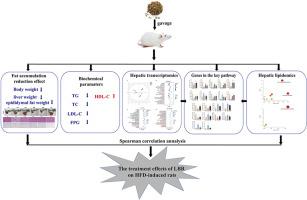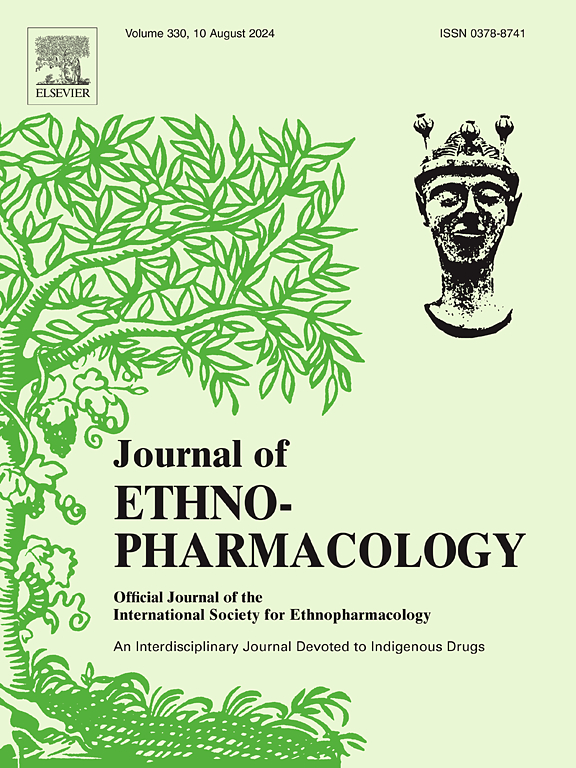整合转录组学和脂质组学揭示柴胡对非酒精性脂肪肝的改善作用
IF 5.4
2区 医学
Q1 CHEMISTRY, MEDICINAL
引用次数: 0
摘要
民族药理学意义:柴胡是治疗肝病最常用的传统中药。虽然柴胡的降脂和保肝作用已被证实,但其在高脂饮食诱发的非酒精性脂肪肝(NAFLD)中的作用仍不明确:本研究的目的是通过肝脏转录组学和脂质组学分析,评估BR活性组分对体内非酒精性脂肪肝的缓解作用,并探索其潜在机制:通过对SD大鼠进行为期8周的高脂饮食(HFD),建立非酒精性脂肪肝模型。随后,对非酒精性脂肪肝模型大鼠连续灌胃不同极性组分的 BR(25 克/千克/天)和褪黑素(MT)(30 毫克/千克/天)6 周,以评估治疗效果。研究人员通过肝脏转录组分析、非靶向脂质组学、RT-qPCR、蛋白质-蛋白质相互作用(PPI)网络构建、分子对接和Western印迹等方法,研究了低极性组分BR(LBR)治疗非酒精性脂肪肝的潜在机制,旨在阐明LBR可能改善非酒精性脂肪肝的潜在机制:结果:这些结果表明,与模型大鼠和其他极性组分的BR相比,LBR能显著减轻HFD诱导的非酒精性脂肪肝的影响,表现为体重(BW)、肝脏重量(LW)和附睾脂肪重量(EFW)的减少。此外,LBR 显著降低了血清和肝脏中的总胆固醇(TC)、甘油三酯(TG)和低密度脂蛋白胆固醇(LDL-C)水平,同时上调了血清中的高密度脂蛋白胆固醇(HDL-C)。从机理上讲,肝脏转录组分析表明,脂肪酸代谢可能是LBR治疗后改善非酒精性脂肪肝的关键途径。脂质组学数据表明,LBR可调节非酒精性脂肪肝大鼠的代谢谱。富集分析表明,甘油磷脂和甘油脂质代谢可能是非酒精性脂肪肝发病的关键途径。RT-qPCR分析表明,LBR可调节这些关键通路中脂质相关基因的表达。此外,斯皮尔曼相关分析表明,脂质代谢生物标志物、病理指标和脂质相关基因之间存在密切关系。此外,蛋白质-蛋白质相互作用(PPI)网络和分子对接分析确定了七个关键靶点,其中 LBR 的六种成分表现出良好的结合能力(<-5.0 kcal/mol)。最后,Western 印迹分析表明,LBR 可上调 PPARα、CPT1 和 FABP1 的表达水平,同时下调 SREBF1 和 SCD1 的表达水平,从而改善代谢,发挥降脂作用:总之,本研究阐明了 BR 活性组分的降脂机制。BR和LBR都是开发针对非酒精性脂肪肝的新型药理制剂的理想候选物质。LBR通过调节脂肪酸、胆固醇、甘油酯和甘油磷脂的代谢,有效改善了高氟酸诱导的非酒精性脂肪肝引起的脂质紊乱。因此,LBR 具有开发为有效降脂疗法的巨大潜力。本文章由计算机程序翻译,如有差异,请以英文原文为准。

Integrative transcriptomics and lipidomics unravels the amelioration effects of Radix Bupleuri on non-alcoholic fatty liver disease
Ethnopharmacological relevance
Radix Bupleuri (Bupleurum chinense DC.) is the most commonly used traditional Chinese medicine (TCM) for the treatment of liver diseases. While the effects of Radix Bupleuri (BR) on lipid-lowering and liver protection have been established, its role in the development of non-alcoholic fatty liver disease (NAFLD) induced by a high-fat diet remains unclear.
Aim of the study
The objective of this study was to evaluate the alleviation effects of the active fraction of BR on NAFLD in vivo and to explore the underlying mechanisms through an analysis of liver transcriptome and lipidomics.
Materials and methods
The NAFLD model was established in SD rats by administering a high-fat diet (HFD) for 8 weeks. Subsequently, the NAFLD model rats were continuously gavaged with different polarity fractions of BR (25 g/kg/d) and melatonin (MT) (30 mg/kg/d) for an additional 6 weeks to assess therapeutic effects. The potential mechanism of the low polarity fraction of BR (LBR) in treating NAFLD was investigated through hepatic transcriptome analysis, non-targeted lipidomics, RT-qPCR, protein-protein interaction (PPI) network construction, molecular docking, and Western blotting, aiming to elucidate the underlying mechanisms by which LBR may ameliorate NAFLD.
Results
These results demonstrated that LBR significantly alleviated the effects of HFD-induced NAFLD, as evidenced by reductions in body weight (BW), liver weight (LW), and epididymal fat weight (EFW) compared to model rats and other polarity fractions of BR. Furthermore, LBR notably down-regulated serum and liver levels of total cholesterol (TC), triglycerides (TG), and low-density lipoprotein cholesterol (LDL-C), while up-regulating high-density lipoprotein cholesterol (HDL-C) in serum. Mechanistically, liver transcriptome analysis indicated that fatty acid metabolism may be a crucial pathway for the improvement of NAFLD following LBR treatment. Lipidomics data suggested that LBR can modulate the metabolic profile in NAFLD rats. Enrichment analysis revealed that glycerophospholipid and glycerolipid metabolism might be key pathways involved in the development of NAFLD. RT-qPCR analysis demonstrated that LBR could regulate the expression of lipid-related genes in these critical pathways. Additionally, Spearman correlation analysis showed a strong relationship between lipid metabolic biomarkers, pathological indices, and lipid-related genes. Moreover, protein-protein interaction (PPI) network and molecular docking analyses identified seven key targets with six ingredients of LBR exhibiting good binding capacity (<−5.0 kcal/mol). Finally, Western blotting analysis indicated that LBR up-regulates the expression levels of PPARα, CPT1, and FABP1 while down-regulating the expression levels of SREBF1 and SCD1, thereby improving metabolism and exerting a lipid-lowering effect.
Conclusion
In conclusion, the present research elucidated the lipid-lowering mechanisms of the active fractions of BR. Both BR and LBR presented themselves as promising candidates for the development of novel pharmacological agents targeting NAFLD. LBR effectively ameliorated lipid disturbances associated with HFD-induced NAFLD by modulating the metabolism of fatty acids, cholesterol, glycerolipid, and glycerophospholipids. Consequently, LBR held significant potential for development as an effective lipid-lowering therapeutic.
求助全文
通过发布文献求助,成功后即可免费获取论文全文。
去求助
来源期刊

Journal of ethnopharmacology
医学-全科医学与补充医学
CiteScore
10.30
自引率
5.60%
发文量
967
审稿时长
77 days
期刊介绍:
The Journal of Ethnopharmacology is dedicated to the exchange of information and understandings about people''s use of plants, fungi, animals, microorganisms and minerals and their biological and pharmacological effects based on the principles established through international conventions. Early people confronted with illness and disease, discovered a wealth of useful therapeutic agents in the plant and animal kingdoms. The empirical knowledge of these medicinal substances and their toxic potential was passed on by oral tradition and sometimes recorded in herbals and other texts on materia medica. Many valuable drugs of today (e.g., atropine, ephedrine, tubocurarine, digoxin, reserpine) came into use through the study of indigenous remedies. Chemists continue to use plant-derived drugs (e.g., morphine, taxol, physostigmine, quinidine, emetine) as prototypes in their attempts to develop more effective and less toxic medicinals.
 求助内容:
求助内容: 应助结果提醒方式:
应助结果提醒方式:


